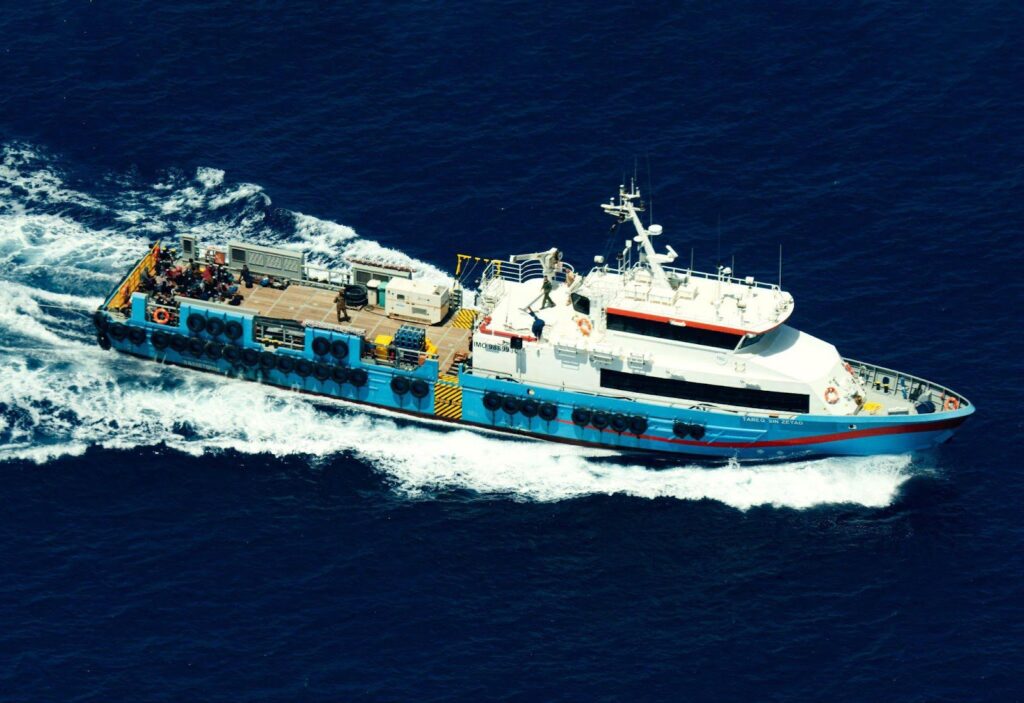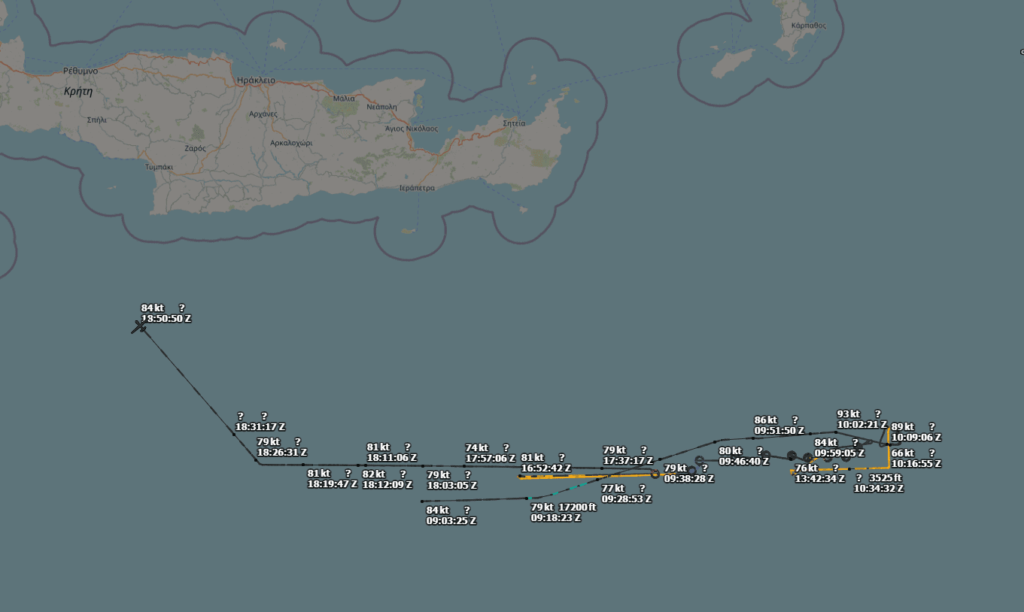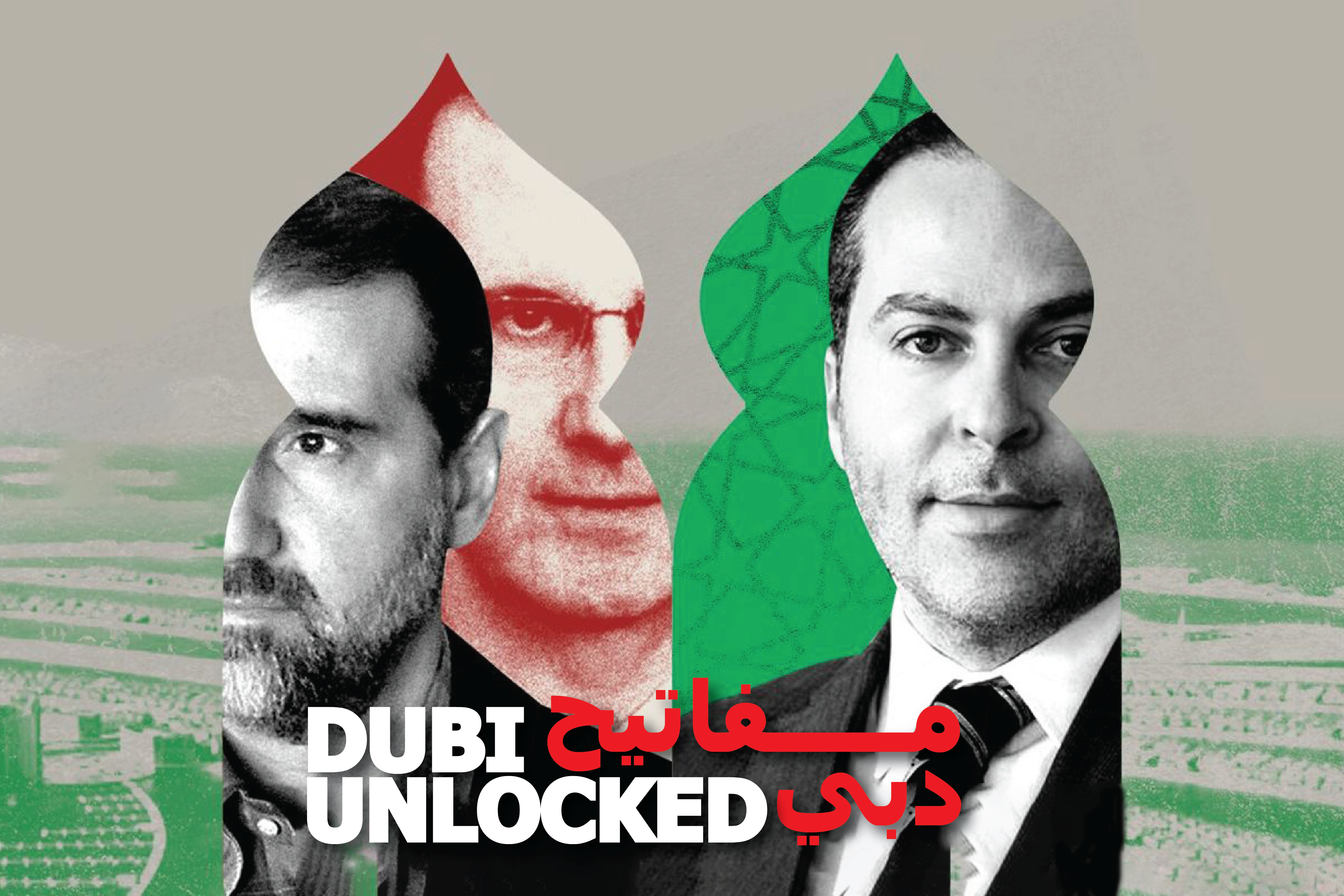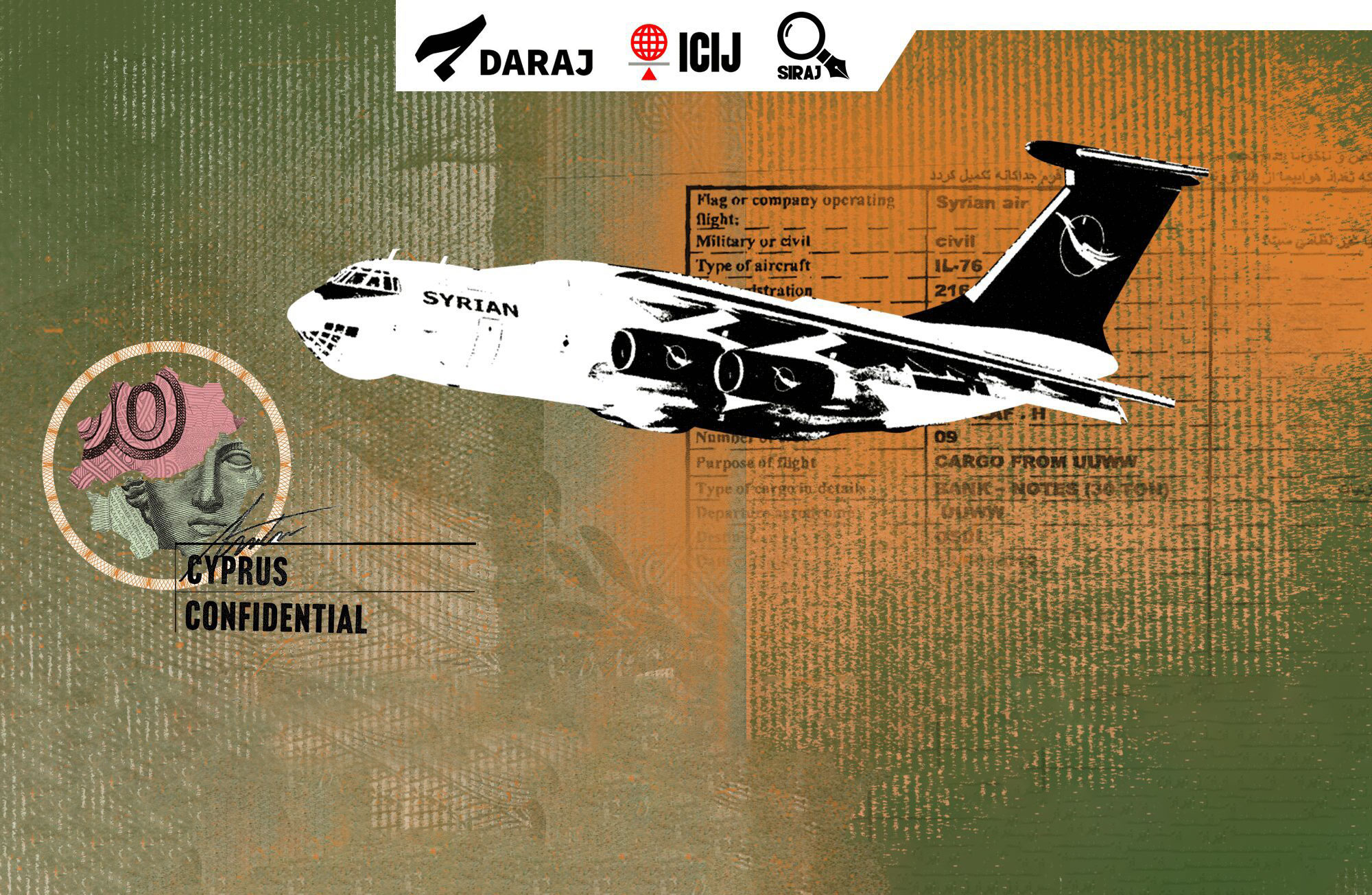For three days, the boat carrying Ahmed, hailing from the city of Daraa in southern Syria, along with 500 migrants of other nationalities, continues to navigate the waters of the Mediterranean Sea, heading north from Tobruk, Libya towards the shores of Italy. The journey began on the night of May 21 from Ain Ghazala.
The young man was hopeful of reaching Europe for a new beginning in life. Although the conditions of the journey aboard the overcrowded boat were far from ideal, he was content as long as he could fulfill his dream of setting foot on European soil. However, their optimism was suddenly disrupted when a blue ship appeared on the horizon and approached them. It circled their boat, causing high waves that affected the balance of their fragile vessel, which almost capsized.
“Should we turn off the engine or drown you?” shouted a person from aboard the approaching ship, carrying a rifle and dressed in military attire. Its passengers quickly pulled out machine guns and began firing towards them. “Our boat was punctured, and the engine was turned off,” Ahmed narrates to the investigative team about what happened that day.
Immediately, one of the military personnel jumped onto the tilting boat and asked to know the identity of the captain/driver. He remained on board with the migrants until nightfall before the operation to tow the exhausted migrants’ boat back to the shores of Libya began by evening, after they had entered the Maltese search and rescue zone.

“It’s the Tareq bin Zeyad ship—the name Tareq bin Zeyad is also written on the ship. I saw it with my own eyes,” adds Ahmed, saying this to the investigative team from a location withheld for security reasons.
But what is the Tareq bin Zeyad ship? Whom does it belong to, and how did it obtain information and coordinates of the migrants’ boat, leading to its retrieval and return to Libya? Who coordinated and managed this communication with the intention of preventing the boat from reaching European search and rescue waters and returning them from there? Each time migrants attempt to travel by boat again, they are forced to start from scratch, in addition to facing various forms of torture and periods of imprisonment, usually ending with their families being asked to pay ransom for their release.
To uncover this covert coordination, SIRAJ collaborated with a group of partners and investigative newsrooms, including Lighthouse Reports, Malta Today, Der Spiegel, Le Monde, Al Jazeera, and Daraj Media to form this investigative report. This collaboration relied on a sequential analysis of maritime and aerial navigation data, examination of documents, interviews with victims who had just emerged from Libyan prisons, Libyan officials, tracking social media accounts, as well as a linguistic analysis of voice recordings by experts in linguistics and language technology at the Institute of Linguistics and Language Technology at the University of Malta. The aim was to analyze the source of voices (in English) recorded from calls of unidentified pilots on the radio.
This investigative report also reveals the entity operating the Tareq bin Zeyad ship, which has become a ghost, haunting migrants in the Mediterranean. It explores how this ship collaborates to tow and return migrants with European entities represented by the Maltese authorities and the European Border and Coast Guard Agency, known by its acronym, Frontex.
The investigative team witnessed at least five cases of towing and returning migrant boats from this ship between May and August of last year. The father of one of the Syrian youths who were on board one of the towed boats says: “My son told me that when he reached Maltese waters, they contacted the Coast Guard and Rescue teams (Italian), who were supposed to come to rescue them and their boat. On the following morning, they were surprised to find the Tareq bin Zeyad ship hovering around them. They tied the boat with a rope and returned it from Malta to Benghazi, imprisoning those on board immediately.”

Tareq bin Zeyad…The Ghost Ship
A video clip captured by one of the aircraft operated by the German non-governmental organization Sea Watch, which is dedicated to search and rescue, shows a ship named Tareq bin Zeyad making its way through the waters of the Mediterranean Sea.
This 42-meter long blue ship is traversed by a wavy red line extending from its bow to its midsection. It is surrounded by black lifebuoys and is distinguished by its ability to sail at a high speed of more than 19 knots.
The ship was manufactured three years ago at the Grandweld Shipyard in Dubai, United Arab Emirates, upon the request of an Iranian maritime services company. It was initially named Charlie 4 in 2020.
According to data from the International Maritime Organization, the ship has been owned by an Emirati company since February 11, 2023. There is not much information available about the company and its activities, leading the investigative team to check its registered address in Dubai. The company’s registered address appears to be a warehouse with some small ships. When a journalist contacted the company’s phone numbers, an employee denied any connection of the company with the Tareq bin Zeyad ship, stating that their activities are limited to ship repairs.
Behind the UAE and Iranian links to the ship, there is mystery surrounding the details of its purchase, the reason for its transfer, and how it ended up in the port of Benghazi. Its arrival came a month after its name was changed from Charlie 4 to TAREQ BIN ZEYAD—the same name as the largest military brigade in eastern Libya, led by military leader Khalifa Haftar’s son, Saddam Haftar, forming part of the Libyan National Army led by Khalifa Haftar.
Information found by the investigative team indicates that the ship’s captain is a middle-aged man with a medium beard, of non-Libyan nationality, whose Facebook account shows he is from Ethiopia. There are photos of him on the ship’s surface dating back to when its name was Charlie 4, and he can be seen in pictures with some Tareq bin Zeyad members near the port, carrying weapons and wearing black masks.
The captain is not the only non-Libyan national crewmember. Testimonies from some migrants we spoke to indicate the presence of technicians and sailors from Indian and Pakistani nationalities among the ship’s leadership.
Moreover, videos on TikTok show young people in their twenties aboard, wearing military uniforms with the emblem “Brigade of Tareq bin Zeyad the enhanced.” Sometimes, they are seen taking pictures in which they gloat by holding their rifles in clothing that matches with the clothing of some of the fanciest Italian designers, praising former Iraqi president Saddam Hussein and former Libyan leader Muammar Al Qaddafi.
Away from Italian designers, barbecues, and dancing to the tunes of Libyan folk songs and American rap music, an Amnesty International report issued last December presents a completely different image of the activities of the Tareq bin Zeyad Brigade, the striking force in eastern Libya. The report, consisting of 21 pages, describes dozens of documented cases of “terrorist and illegal activities practiced by members of this brigade, including kidnapping for ransom, murder, rape, and torture against migrants and individuals openly opposing Haftar’s policies in eastern and southern Libya.”
The smuggling maze investigation that SIRAJ and its partners learned about in July last year revealed the activity of an international smuggling network in eastern Libya, transporting migrants by air from their countries like Syria to Benina Airport in Benghazi. They were then sent on fishing trawlers (boats) in perilous journeys that could end in the drowning of hundreds of them.
Cooking Rice in Seawater
It has been over two weeks since the members of the Tareq bin Zeyad Brigade towed Bassel and his companions’ boat on August 18 from the Maltese search and rescue zone. Throughout this period, the “kidnappers,” as they are described, had not provided him with any normal meal except for rice cooked in salty seawater.
On that day, Bassel, a Syrian man in his thirties and a father of two, the eldest being five years old, was undergoing his daily torture routine at one of the Benghazi port points controlled by the 20-20 Brigade, which is affiliated with Tareq bin Zeyad.
The routine torture began with brutal beatings, after which Bassel was taken to the edge of the port, to be thrown into the 10-meter-deep sea and left there for hours while trying to swim to avoid drowning. Meanwhile, the seawater aggravated the wounds left by the torture on his body.
When the armed man pulled him out of the seawater, Bassel noticed something unusual. The man was holding a bottle of water, a loaf of bread, and a boiled egg.
“This is your last day. Eat this meal and drink the water now because in hell, there is no water,” one of the men told him. The feeling of hunger at that moment was much stronger than the impact of the death sentence on him, Bassel told the investigative team, recalling that moment: “I ate as if I hadn’t heard my death sentence. I was very hungry.”
Next to the man who gave him water and food, a bearded clergyman stood. “They dressed me in an orange suit, ordered me to place my head on the wall, put my hands behind my back, asked me to recite the shahada, insulted me with the worst words, and then opened fire with their rifles.”

Two weeks prior, Bassel and his companions were still in international waters under the jurisdiction of the Greek search and rescue zone. He remembers well what happened two days before his arrest on August 16, saying, “We were between Cyprus and Greece when we saw a reconnaissance plane hovering over our boat. It continued for a while. The boat’s captain told us it was a Greek reconnaissance plane.”

A screenshot from the ADSB Exchange website tracking aircraft shows the flight path of the Frontex Heron 1 drone as it circled and hovered around the boat carrying Bassel and his companions on August 16, 2023.
The investigative team verified Bassel’s account by reviewing flight data between Greece and Cyprus. They found a drone flight for a Heron 1 aircraft operated by Frontex, circling various points on August 16 in an east-to-west sequence. This indicates that the drone was monitoring a boat coming from the shores of the eastern Mediterranean heading west, aligning with the timeline provided by Bassel to the investigative team.
Two days after Frontex tracked the boat carrying Bassel and other migrants, we observed the same drone flying over Bassel’s boat within the Maltese search and rescue area. The drone followed the same path as the boat traveling from east to west, consistent with Bassel’s boat trajectory.
When we questioned Frontex about tracking Bassel’s boat twice, they confirmed through their media office that the drone did indeed spot the boat two days before it was intercepted by Tareq bin Zeyad. They also witnessed the return operation two days later by the Tareq bin Zeyad ship.
Frontex affirmed that they acted according to protocol: after the initial boat sighting, they informed the authorities in Greece and Malta about the boat, while denying any knowledge of how the ship obtained the boat’s coordinates before intercepting and returning it to Benghazi.
The Greek Ministry of Foreign Affairs, in response to the investigation’s findings, stated that the boat was in the Maltese search and rescue area when Frontex informed them. They claim to have followed the law, informing the Maltese authorities about the boat as soon as they knew. However, Malta has not responded to journalists’ questions about whether they shared Bassel’s boat coordinates with the Tareq bin Zeyad.
Dana Schmalz, a research fellow at the Max Planck Institute for Public Law and International Law, said: “According to European Union law, Frontex must act in ways that respect human rights in all its operations. Therefore, coordinates should not be passed in a way that leads to violent interceptions by militias engaging in the torture of migrants.”
The Witness Identifies his Torturers
Somewhere inside the port of Benghazi, Bassel was preparing for his execution. “When I heard the sound of gunfire around me, I fell to the ground. I examined my body, searching for blood, before the bearded man and the elements burst into laughter at my condition. I was in a state of unconsciousness at that moment and did not know whether I was alive or dead,” says Bassel in a trembling voice.
The feigned execution by the brigade members was not the end of the torture. Bassel recounted other events of beating, humiliation, and torture. They would immerse him daily in salty seawater for several hours to burn his wounds after beating and torturing him. After a period, he was transferred to a villa belonging to one of the infamous warlords in eastern Libya, forcing him to work for free in the villa’s garden, which housed several predatory animals.
Bassel’s ordeal only ended after several weeks when he was transferred to another armed group, which negotiated his release with his relatives. After a period of negotiations, an agreement was reached to release him for a sum of 4,000 euros. Bassel was eventually released after about two months of captivity.
Bassel’s case is one of the rare instances documented where an individual was subjected to torture and abduction after Frontex tracked his boat. Consequently, the investigative team sought additional evidence to confirm the main allegations in Bassel’s testimony.
In addition to examining flight records, we obtained a report on the case of ‘forced or involuntary disappearance’ submitted by Bassel’s relatives to the United Nations Working Group on Enforced or Involuntary Disappearances during his abduction.
The person who negotiated with the abductors on behalf of Bassel shared a conversation that took place between him and a person with a Libyan number via with the journalists. Upon investigation of the Libyan number in the conversation, it was found to belong to an individual working with the Ministry of Justice in eastern Libya.
When we showed Bassel a picture of the person involved in the conversation, he immediately confirmed that the guy was among the individuals who tortured him. He also recognized most of the armed men on board the ship when their pictures were shown to him.
A Broadcast Through the Airwaves to Tareq bin Zeyad
The investigative team obtained a voice message recorded by the Open Arms ship, which belongs to a non-governmental rescue organization. It was recorded on August 2 at 05:45 GMT on channel 16, an open channel that all ships and aircrafts can monitor, for sending and receiving distress calls at sea via radio waves.
The message sender says:
Approximately 11 hours after broadcasting the call on channel 16, at 16:36 GMT, a reconnaissance aircraft belonging to the non-governmental organization Sea Watch was monitoring the waters of the Mediterranean in search of migrant boats that might be in danger. At that time, the plane spotted the ship Tareq bin Zeyad, carrying many migrants within Maltese waters, heading south.
To find the sender who provided Tareq bin Zeyad with the coordinates, and who did not identify himself, the investigative team examined all flights coming from Malta on that day. They obtained real-time flight monitoring data from Sea Watch, showing one of the screenshots taken by a member of the organization at 06:52 GMT. The image indicates the presence of an aircraft belonging to the Maltese Air Force coming from the location of the coordinates shared on the radio at 05:45 GMT. This suggests the possibility that the unknown sender may have been on board that plane, as it was coming from the same coordinates, one hour and seven minutes after sharing the coordinates on radio channel 16.
The investigative team contacted the Maltese Armed Forces and shared the audio recording with them to determine whether their aircraft was communicating with the Tareq bin Zeyad. In response, the Maltese Armed Forces did not confirm or deny communication with the ship, stating that maritime personnel are obligated to share information with other ships in the area.
To go beyond the confirmation or denial by Maltese authorities, the investigative team sought assistance from Alexandra Vella and Sarah Grech, professors at the Institute of Linguistics and Language Technology at the University of Malta. They analyzed the audio recording in English on channel 16 and provided the investigative team with a detailed analytical report.
According to the analysis, it was confirmed that the speaker in the recording is Maltese. This conclusion was drawn from identifying several characteristics in the speaker’s accent, which align with Maltese language features, indicating that the speaker’s native language is Maltese.
Nora Markard, Professor of Public International Law and International Human Rights Law at the University of Münster, Germany, commented on Malta’s sharing of coordinates with Tareq bin Zeyad, stating: “This is a clear violation of maritime law. This case could be described as interception through the use of an intermediary, as Tareq bin Zeyad, in this case, intercepted the boat on behalf of Malta.”
Piracy and Kidnapping at Sea or Rescue?
On July 26, 2022, at around 1:00 PM, 24-year-old Khaled, hailing from Manbij in northern Syria, along with two hundred other migrants, advanced in their boat inside the Maltese search and rescue area. They were surprised by a ship approaching them flying the Libyan flag, asking them to stop the engine.
The name Tareq bin Zeyad written on its side and the Libyan flag fluttering on its mast raised suspicions among the boat’s passengers, who refused to stop the engine and attempted to escape.
Their decision to resist did not sit well with the armed individuals on the ship’s deck. “They hit our ship from the right side, then one of the military personnel took out a powerful water cannon and opened it on us. Fear spread among men, women, and children. Some burst into tears, and the elderly began to shout at the captain, demanding him to stop,” recalls Khaled, remembering how the ship’s crew forced them back to Benghazi.
For Bassel and Ahmed, whose boat faced a similar fate, their story began with the sighting of their boat by a reconnaissance aircraft belonging to Frontex that morning.
Frontex states that its aircraft saw the boat at 07:17 GMT, and, due to overcrowding, the organization’s experts decided to send a distress call with the boat’s coordinates to all ships in the area.
According to Frontex, no ship responded to this call except Tareq bin Zeyad, which expressed its readiness to carry out a “rescue operation.”
The investigative team observed the movement of passing ships in that area through maritime navigation websites and found two ships close to Khaled’s boat. Neither of these two ships changed their course after hearing the distress call. When the team contacted one of the ships to verify receiving the call for immediate rescue, the response was that they had not received any instructions from the relevant authorities.
Frontex states that it contacted all rescue coordination centers in the maritime area and did not receive any response. After sending the distress call, its aircraft continued to hover around the boat for about an hour before returning to its base due to fuel depletion.
Legal expert Nora Markard commented on this situation, stating: “Frontex knows who the Tareq bin Zeyad is and what this militia is doing. Frontex knows that this situation is closer to a kidnapping than a rescue operation. It is evident that maritime rescue coordination centers did not take charge of coordinating the case at all, and Frontex should have assumed that the militia would take the individuals on the boat, contrary to international law, to an unsafe place where they might face further violations.”
Coast Guard or Armed Militias?
The investigative team examined one of the daily work reports from last August regarding rescue operations in the Mediterranean border regions carried out by Frontex, in addition to many other documents.
In the report, the team found a reference to a migrant boat spotted by one of Frontex’s aircraft on August 16 near the shores of Misrata. The report indicates that Frontex shared the coordinates with the Libyan Search and Rescue Center in Tripoli, and the migrant boat ended up being returned to Libya by a vessel belonging to the Libyan Coast Guard named “Tareq.”
Brigadier Bashir Balnour, Director of the General Administration of Coastal Security, denied any direct leadership over Tareq ben Ziyad, stating that they cooperate with them occasionally.
However, Frontex confirmed in its responses to the investigative team that Tareq is Tareq bin Zeyad, considering the ship as a coast guard vessel.
On the other hand, Major Masoud Abdel Samad, Operations Director at the Libyan Coast Guard in Tripoli, denied that the Tariq bin Ziyad is affiliated with the Libyan Coast Guard in Tripoli, stating that they share coordinates when needed by the Coast Guards in Benghazi who in turn can delegate whoever they want, as long as the operation is done.
Frontex’s collaboration with the Libyan Coast Guard affiliated with the Dbeibeh government in western Libya is known to followers of rescue affairs in the region. Simultaneously, it sparks controversy among the European public, as numerous reports and investigations have highlighted various attacks, such as kidnapping, ransom demands, forced labor, or even rape, against migrants returned to Libya.
The European Court of Human Rights previously ruled that migrants should not be returned to Libya because they would be exposed to torture and death. Governments justified their actions by stating that the Libyan Coast Guard is responsible for its search and rescue area, despite its unfavorable outcomes. This aligns with their reluctance to accept more migrants.
The documented cases in the investigation show that Malta directly shared coordinates of migrant boats with the Tareq bin Zeyad militia on several occasions. Frontex’s sharing of boat coordinates with the Tripoli government means that the coordinates might find their way to militias kidnapping and torturing migrants in eastern Libya, with the ultimate goal of seeking out ransoms from the migrants’ families in eastern Libya.
Markard commented on this entanglement, saying, “Frontex and national rescue coordination centers should not provide information to any Libyan party. There is enough documentation of human rights violations against refugees returned by the Libyans. Libya is not a safe place.”
Many European countries, including Italy and Malta, seek to strengthen their ties with General Khalifa Haftar, the strongman ruling eastern Libya, to execute and secure their interests on the other side of the Mediterranean, hoping to assist in curbing illegal migrant flows departing from Libyan shores.
On May 8, the same month during which the Tareq bin Zeyad returned Ahmed’s boat with 500 migrants from Maltese waters, the Italian Prime Minister Giorgia Meloni held a meeting with General Khalifa Haftar, this time on Libyan territory in the Barqa region, to discuss migration files and mutual cooperation. The Italian Foreign Minister, Antonio Tiani, considered Haftar to be the most powerful figure, asserting that it is appropriate to talk to him about migration.
As European countries continue to enhance internal protective policies to prevent more waves of refugees from North Africa, specifically Libya, from reaching their territories, Bassel seeks to recover from his ordeal. He says, “Everything in my life changed after the incident. My physical wounds healed, but the psychological effects of torture have not left me yet.”
A version of this investigation was published in Arabic on Daraj, and Jana Barkat participated in its preparation.
The names of witnesses have been changed for security reasons and to protect their identities.
The Source: DARAJ.



